Hydrological Effects of Bioretention Facilities in an Environment with a High Groundwater Table and Their Impacts on Groundwater
Abstract
:1. Introduction
2. Materials and Methods
2.1. Experimental Devices and Materials
2.1.1. Experimental Device
2.1.2. Experimental Materials
2.2. Experimental Design
2.2.1. Simulated Rainfall
2.2.2. Monitoring of Parameters
2.3. Analytical Method
3. Results and Discussion
3.1. Synergistic Effect of Facility Structure and Medium Soil
3.1.1. Influence of Drain Pipe Design on Hydrological Performance of the Facility and Groundwater Recharge
3.1.2. Influence of the Confluence Ratio on the Hydrological Performance of the Facility and Groundwater Recharge
3.2. Coupled Influence of Rainfall Characteristics and the Dynamics of the Groundwater Table
3.2.1. Response of Soil Moisture to Rainfall Interval
3.2.2. Influence of Rainfall Intensity on the Hydrological Performance of the Facility and Groundwater Recharge
3.2.3. Influence of the Groundwater Table on the Hydrological Performance of the Facility and Groundwater Recharge
| Experimental Conditions | Inflow Volume/L | #1 Recharge Volume/L | #2 Recharge Volume/L | #3 Recharge Volume/L | #1 Recharge Coefficient α | #2 Recharge Coefficient α | #3 Recharge Coefficient α | |
|---|---|---|---|---|---|---|---|---|
| Groundwater table/m | 0.2 | 34.34 | 28.72 | 28.13 | 29.95 | 0.84 | 0.82 | 0.87 |
| 0.3 | 34.34 | 29.44 | 28.68 | 30.53 | 0.86 | 0.84 | 0.89 | |
| 0.5 | 34.34 | 30.33 | 29.55 | 31.87 | 0.88 | 0.86 | 0.93 | |
| Drainage pipe | Set up | 34.34 | 15.1 | / | 21.7 | 0.44 | / | 0.63 |
| No | 34.34 | 28.72 | 28.13 | 29.95 | 0.84 | 0.82 | 0.87 | |
| Confluence ratio | 10 | 34.34 | 28.72 | 28.13 | 29.95 | 0.84 | 0.82 | 0.87 |
| 20 | 68.68 | 40.1 | 39.06 | 46.38 | 0.58 | 0.57 | 0.68 | |
| Rainfall interval/day | 7 | 34.34 | 28.72 | 28.13 | 29.95 | 0.84 | 0.82 | 0.87 |
| 14 | 34.34 | 27.2 | 27.04 | 29.4 | 0.79 | 0.79 | 0.86 | |
| Rainfall intensity/mm | 4.44 | 10 | 8.9 | 8.67 | 9.41 | 0.89 | 0.87 | 0.94 |
| 15.26 | 34.34 | 28.72 | 28.13 | 29.95 | 0.84 | 0.82 | 0.87 | |
| 41.37 | 92.48 | 45.63 | 38.86 | 46.3 | 0.49 | 0.42 | 0.50 | |
| Groundwater Table (m) | Device Number | Rainfall Intensity (mm) | Rainwater Volume Entering the Device (L) | Drainage Volume of the Drain Pipe (L) | Groundwater Recharge Volume (L) | Ratio of the Drainage Volume to the Inflow (%) | Ratio of the Recharge Volume to the Inflow (%) |
|---|---|---|---|---|---|---|---|
| 0.5 | #1 | 15.26 | 34.3 | 26 | 5.84 | 76% | 17% |
| #3 | 15.26 | 34.3 | 19.9 | 13.29 | 58% | 39% | |
| 0.2 | #1 | 15.26 | 34.3 | 17.7 | 15.1 | 52% | 44% |
| #3 | 15.26 | 34.3 | 10.5 | 21.7 | 31% | 63% |
3.3. Influence of the Matrix and Soil Types on the Hydrological Performance of the Facility and Groundwater Recharge
4. Conclusions
Author Contributions
Funding
Data Availability Statement
Conflicts of Interest
References
- Yang, D.; Yang, Y.; Xia, J. Hydrological cycle and water resources in a changing world: A review. Geogr. Sustain. 2021, 2, 115–122. [Google Scholar]
- Gleeson, T.; Befus, K.M.; Jasechko, S.; Luijendijk, E.; Cardenas, M.B. The global volume and distribution of modern groundwater. Nat. Geosci. 2016, 9, 161–167. [Google Scholar] [CrossRef]
- Jasechko, S.; Seybold, H.; Perrone, D.; Fan, Y.; Shamsudduha, M.; Taylor, R.G.; Fallatah, O.; Kirchner, J.W. Rapid groundwater decline and some cases of recovery in aquifers globally. Nature 2024, 625, 715–721. [Google Scholar] [PubMed]
- Gorelick, S.M.; Zheng, C. Global change and the groundwater management challenge. Water Resour. Res. 2015, 51, 3031–3051. [Google Scholar] [CrossRef]
- He, C.; Liu, Z.; Wu, J.; Pan, X.; Fang, Z.; Li, J.; Bryan, B.A. Future global urban water scarcity and potential solutions. Nat. Commun. 2021, 12, 4667. [Google Scholar] [CrossRef]
- Raimondi, A.; Quinn, R.; Abhijith, G.R.; Becciu, G.; Ostfeld, A. Rainwater harvesting and treatment: State of the art and perspectives. Water 2023, 15, 1518. [Google Scholar] [CrossRef]
- Shi, C.; Li, Y.; Li, H.; Qiu, H.; Xu, T. Towards sustainable urban water management: An ecological compensation framework for sponge cities. Environ. Res. Lett. 2024, 19, 123002. [Google Scholar]
- Wang, M.; Zhang, D.Q.; Su, J.; Dong, J.W.; Tan, S.K. Assessing hydrological effects and performance of low impact development practices based on future scenarios modeling. J. Clean. Prod. 2018, 179, 12–23. [Google Scholar] [CrossRef]
- Chui, T.F.M.; Liu, X.; Zhan, W. Assessing cost-effectiveness of specific LID practice designs in response to large storm events. J. Hydrol. 2016, 533, 353–364. [Google Scholar] [CrossRef]
- Xia, J.; Zhang, Y.; Xiong, L.; He, S.; Wang, L.; Yu, Z. Opportunities and challenges of the Sponge City construction related to urban water issues in China. Sci. China Earth Sci. 2017, 60, 652–658. [Google Scholar] [CrossRef]
- Qiao, X.-J.; Liao, K.-H.; Randrup, T.B. Sustainable stormwater management: A qualitative case study of the Sponge Cities initiative in China. Sustain. Cities Soc. 2020, 53, 101963. [Google Scholar]
- Li, J.; Zhao, R.; Li, Y.; Li, H. Simulation and optimization of layered bioretention facilities by HYDRUS-1D model and response surface methodology. J. Hydrol. 2020, 586, 124813. [Google Scholar]
- Vijayaraghavan, K.; Biswal, B.K.; Adam, M.G.; Soh, S.H.; Tsen-Tieng, D.L.; Davis, A.P.; Chew, S.H.; Tan, P.Y.; Babovic, V.; Balasubramanian, R. Bioretention systems for stormwater management: Recent advances and future prospects. J. Environ. Manag. 2021, 292, 112766. [Google Scholar]
- Shrestha, P.; Hurley, S.E.; Wemple, B.C. Effects of different soil media, vegetation, and hydrologic treatments on nutrient and sediment removal in roadside bioretention systems. Ecol. Eng. 2018, 112, 116–131. [Google Scholar]
- Su, J.; Wang, M.; Zhang, D.; Sun, C.; Zhao, X.; Razi, M.A.B.M. A systematic and bibliometric review of bioretention system (BRS) for urban ecosystem regulation services. Urban Clim. 2024, 55, 101923. [Google Scholar] [CrossRef]
- Søberg, L.C.; Winston, R.; Viklander, M.; Blecken, G.-T. Dissolved metal adsorption capacities and fractionation in filter materials for use in stormwater bioretention facilities. Water Res. X 2019, 4, 100032. [Google Scholar] [PubMed]
- Palanisamy, B.; Borkar, R.; Sangeetha, K.; Narasimhan, B. Evaluation of augmented infiltration based LIDs for low lying urbanizing coastal catchments: A case study of Chennai city, India. Urban Water J. 2024, 21, 638–655. [Google Scholar] [CrossRef]
- Zhang, K.; Chui, T.F.M.; Yang, Y. Simulating the hydrological performance of low impact development in shallow groundwater via a modified SWMM. J. Hydrol. 2018, 566, 313–331. [Google Scholar]
- D’Aniello, A.; Cimorelli, L.; Cozzolino, L.; Pianese, D. The effect of geological heterogeneity and groundwater table depth on the hydraulic performance of stormwater infiltration facilities. Water Resour. Manag. 2019, 33, 1147–1166. [Google Scholar]
- Zheng, Y.; Chen, S.; Qin, H.; Jiao, J.J. Modeling the spatial and seasonal variations of groundwater head in an urbanized area under low impact development. Water 2018, 10, 803. [Google Scholar] [CrossRef]
- Kim, H.; Mallari, K.J.B.; Baek, J.; Pak, G.; Choi, H.I.; Yoon, J. Considering the effect of groundwater on bioretention using the Storm Water Management Model. J. Environ. Manag. 2019, 231, 1270–1276. [Google Scholar] [CrossRef] [PubMed]
- Chui, T.F.M.; Trinh, D.H. Modelling infiltration enhancement in a tropical urban catchment for improved stormwater management. Hydrol. Process. 2016, 30, 4405–4419. [Google Scholar] [CrossRef]
- Jiang, Y.; Li, J.; Gao, J.; Xia, J. A multi-objective optimization and evaluation framework for LID facilities considering urban surface runoff and shallow groundwater regulation. J. Clean. Prod. 2024, 478, 143921. [Google Scholar]
- Zhang, K.; Chui, T.F.M. Interactions between shallow groundwater and low-impact development underdrain flow at different temporal scales. Hydrol. Process. 2018, 32, 3495–3512. [Google Scholar]
- Zhang, K.; Chui, T.F.M. Evaluating hydrologic performance of bioretention cells in shallow groundwater. Hydrol. Process. 2017, 31, 4122–4135. [Google Scholar]
- Locatelli, L.; Mark, O.; Mikkelsen, P.S.; Arnbjerg-Nielsen, K.; Wong, T.; Binning, P.J. Determining the extent of groundwater interference on the performance of infiltration trenches. J. Hydrol. 2015, 529, 1360–1372. [Google Scholar]
- Jackisch, N.; Weiler, M. The hydrologic outcome of a Low Impact Development (LID) site including superposition with streamflow peaks. Urban Water J. 2017, 14, 143–159. [Google Scholar] [CrossRef]
- Zhang, K.; Chui, T.F.M. Design measures to mitigate the impact of shallow groundwater on hydrologic performance of permeable pavements. Hydrol. Process. 2020, 34, 5146–5166. [Google Scholar] [CrossRef]
- Hillel, D. Environmental Soil Physics: Fundamentals, Applications, and Environmental Considerations; Elsevier Science: Amsterdam, The Netherlands, 2014. [Google Scholar]
- Bear, J. Dynamics of Fluids in Porous Media; Courier Corporation: New York, NY, USA, 2013. [Google Scholar]
- Locatelli, L.; Mark, O.; Mikkelsen, P.S.; Arnbjerg-Nielsen, K.; Jensen, M.B.; Binning, P.J. Modelling of green roof hydrological performance for urban drainage applications. J. Hydrol. 2014, 519, 3237–3248. [Google Scholar] [CrossRef]
- Le Coustumer, S.; Fletcher, T.D.; Deletic, A.; Barraud, S.; Poelsma, P. The influence of design parameters on clogging of stormwater biofilters: A large-scale column study. Water Res. 2012, 46, 6743–6752. [Google Scholar] [CrossRef]
- Kandra, H.; McCarthy, D.; Deletic, A. Assessment of the impact of stormwater characteristics on clogging in stormwater filters. Water Resour. Manag. 2015, 29, 1031–1048. [Google Scholar] [CrossRef]
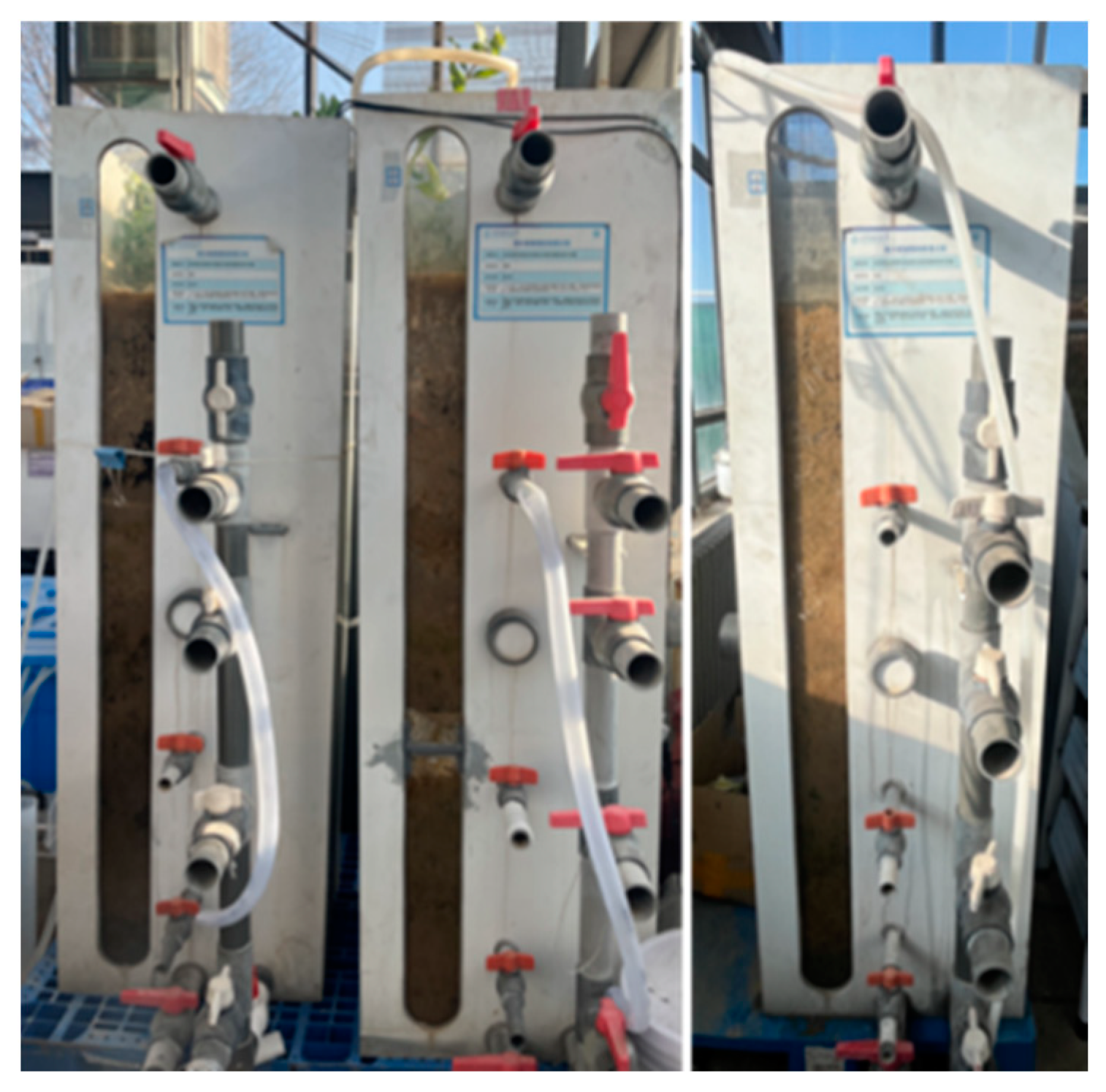
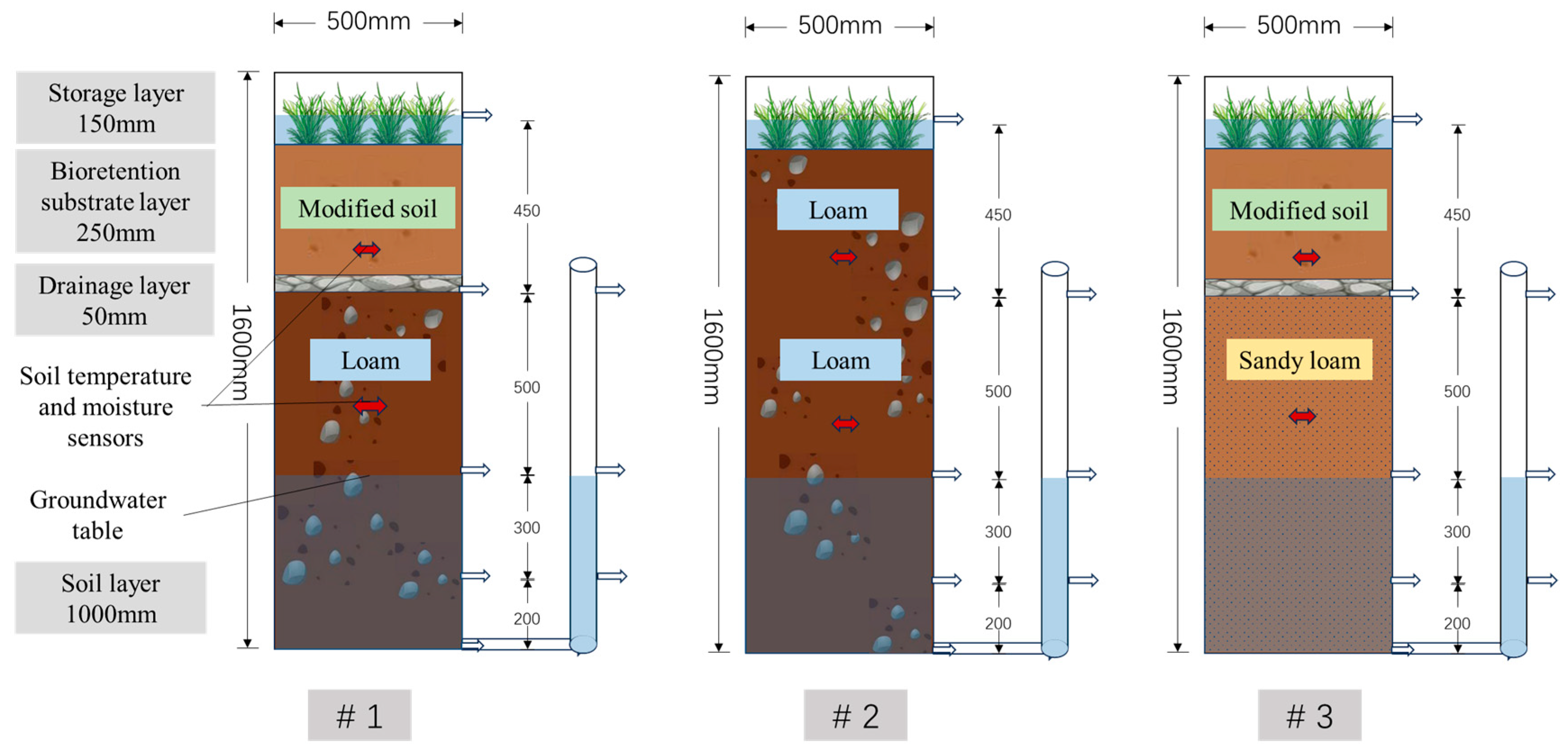

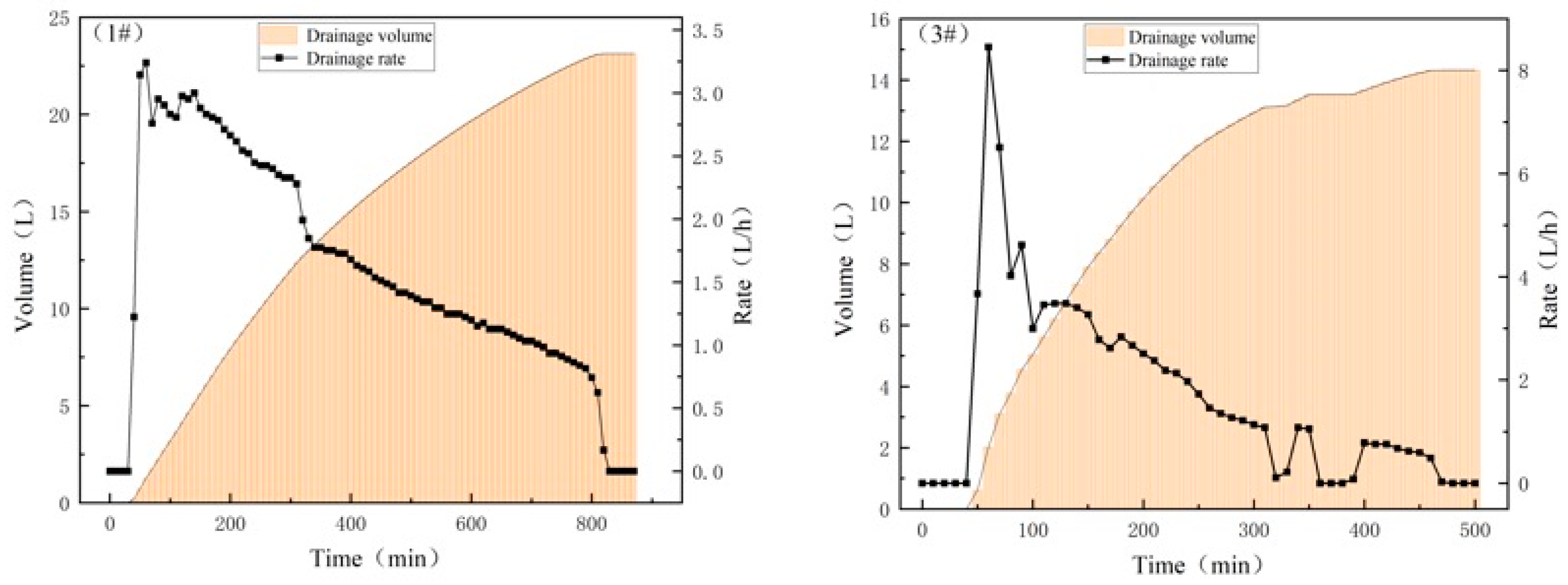
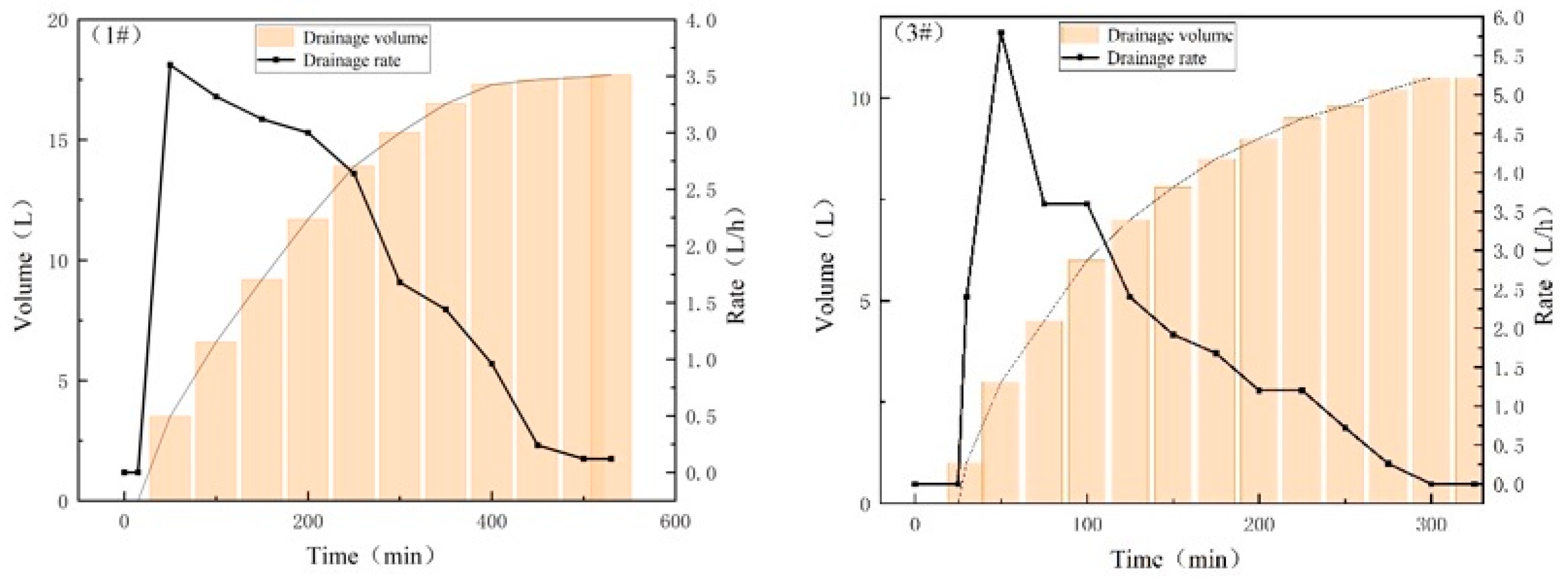
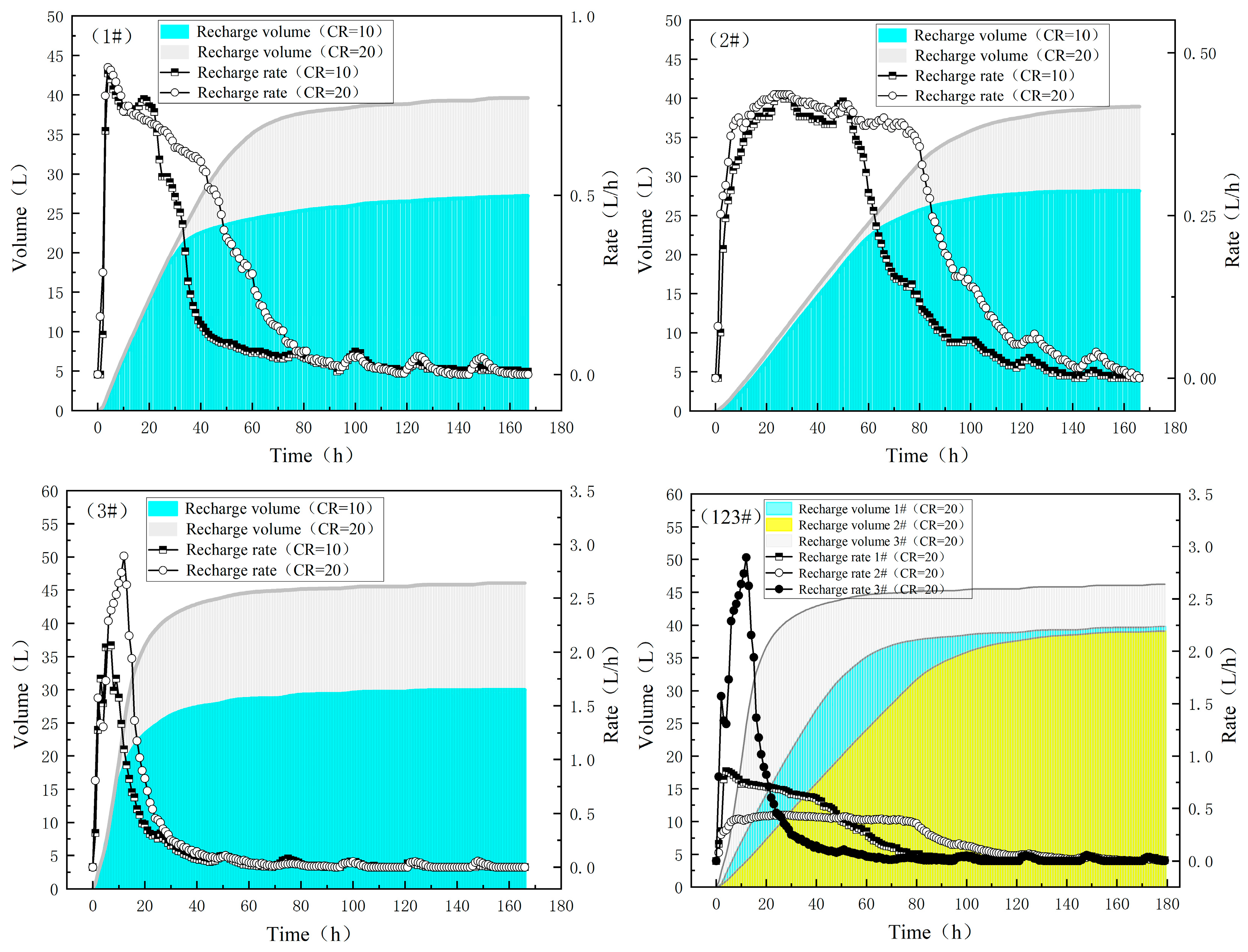

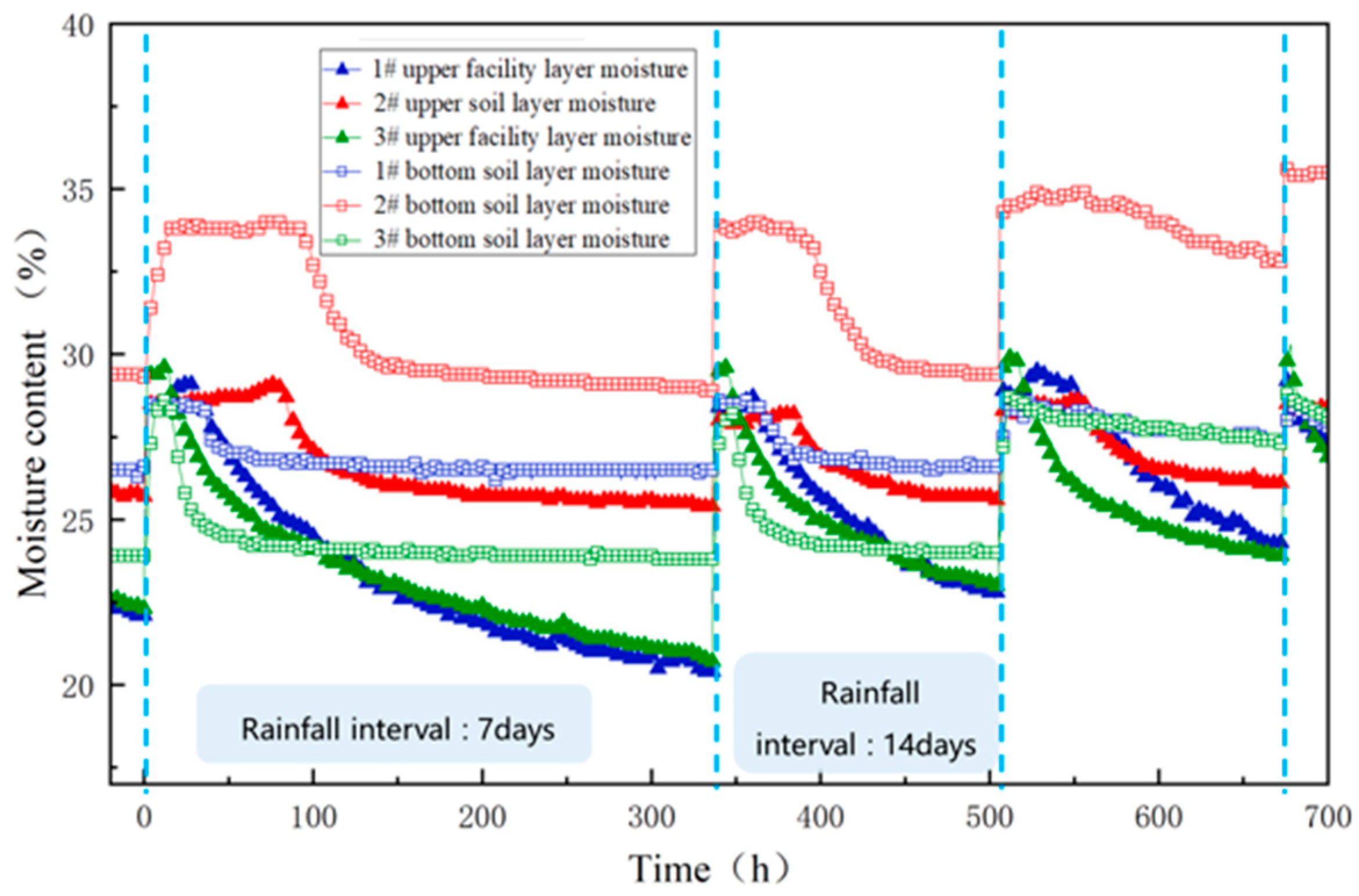




| Medium Type | Bulk Density (g/cm3) | Saturated Volumetric Water Content (cm3·cm⁻3) | Saturated Hydraulic Conductivity (mm·h⁻1) |
|---|---|---|---|
| Sandy loam | 1.78 | 0.30 | 10.84 |
| Loam | 1.59 | 0.37 | 1.86 |
| Modified soil | 0.82 | 0.29 | 54 |
| Experiment Number | Groundwater Table (m) | IDGW (m) | Drainage Pipe | Confluence RATIO | Rainfall Interval (day) | Rainfall Intensity (mm) |
|---|---|---|---|---|---|---|
| 1 | 0.2 | 0.8 | Without | 10: 1 | 7 | 41.37 |
| 2 | 0.2 | 0.8 | Set up | 10: 1 | 7 | 41.37 |
| 3 | 0.2 | 0.8 | Without | 10: 1 | 7 | 15.26 |
| 4 | 0.2 | 0.8 | Without | 20: 1 | 7 | 15.26 |
| 5 | 0.2 | 0.8 | Without | 10: 1 | 14 | 15.26 |
| 6 | 0.5 | 0.5 | Without | 10: 1 | 7 | 15.26 |
| 7 | 0.5 | 0.5 | Set up | 10: 1 | 7 | 15.26 |
| 8 | 0.3 | 0.7 | Without | 10: 1 | 7 | 15.26 |
| 9 | 0.3 | 0.7 | Without | 10: 1 | 7 | 32.90 |
| 10 | 0.3 | 0.7 | Without | 10: 1 | 7 | 4.44 |
| 11 | 0.2 | 0.8 | Without | 10: 1 | 14 | 4.44 |
| 12 | 0.2 | 0.8 | Set up | 10: 1 | 7 | 15.26 |
| Drainage Pipe | Rainfall Intensity (mm) | Device Number | Inflow Volume (L) | Overflow Volume (L) | Groundwater Recharge Volume (L) | Drainage Volume of the Drain Pipe (L) | Recharge Coefficient α |
|---|---|---|---|---|---|---|---|
| Without | 41.37 | #1 | 92.48 | 46.6 | 45.63 | / | 0.49 |
| 41.37 | #3 | 92.48 | 43 | 46.29 | / | 0.50 | |
| Set up | 41.37 | #1 | 92.48 | 46.5 | 20.98 | 23.13 | 0.23 |
| 41.37 | #3 | 92.48 | 38 | 37.81 | 14.32 | 0.41 | |
| Without | 15.26 | #1 | 34.3 | 0 | 28.72 | / | 0.84 |
| 15.26 | #3 | 34.3 | 0 | 29.95 | / | 0.87 | |
| Set up | 15.26 | #1 | 34.3 | 0 | 15.1 | 17.7 | 0.44 |
| 15.26 | #3 | 34.3 | 0 | 21.7 | 10.5 | 0.63 |
| Confluence Ratio | Device Number | Peak Value of Recharge Rate (L/h) | Peak Time (h) | Groundwater Recharge Volume (L) | Recharge Coefficient α |
|---|---|---|---|---|---|
| 20:1 | #1 | 0.86 | 4 | 40.1 | 0.58 |
| #2 | 0.44 | 25 | 39.06 | 0.57 | |
| #3 | 2.9 | 12 | 46.38 | 0.68 | |
| 10:1 | #1 | 0.91 | 5 | 28.72 | 0.84 |
| #2 | 0.44 | 24 | 28.13 | 0.82 | |
| #3 | 2 | 5 | 29.95 | 0.87 |
Disclaimer/Publisher’s Note: The statements, opinions and data contained in all publications are solely those of the individual author(s) and contributor(s) and not of MDPI and/or the editor(s). MDPI and/or the editor(s) disclaim responsibility for any injury to people or property resulting from any ideas, methods, instructions or products referred to in the content. |
© 2025 by the authors. Licensee MDPI, Basel, Switzerland. This article is an open access article distributed under the terms and conditions of the Creative Commons Attribution (CC BY) license (https://creativecommons.org/licenses/by/4.0/).
Share and Cite
Wang, Y.; Yang, Y.; Liu, H.; Qi, Z.; Tian, S.; Mo, X.; Chen, H.; Gong, Y. Hydrological Effects of Bioretention Facilities in an Environment with a High Groundwater Table and Their Impacts on Groundwater. Water 2025, 17, 1096. https://doi.org/10.3390/w17071096
Wang Y, Yang Y, Liu H, Qi Z, Tian S, Mo X, Chen H, Gong Y. Hydrological Effects of Bioretention Facilities in an Environment with a High Groundwater Table and Their Impacts on Groundwater. Water. 2025; 17(7):1096. https://doi.org/10.3390/w17071096
Chicago/Turabian StyleWang, Yuhui, Yilan Yang, Haolang Liu, Zizhen Qi, Siyu Tian, Xiangjing Mo, Hanbo Chen, and Yongwei Gong. 2025. "Hydrological Effects of Bioretention Facilities in an Environment with a High Groundwater Table and Their Impacts on Groundwater" Water 17, no. 7: 1096. https://doi.org/10.3390/w17071096
APA StyleWang, Y., Yang, Y., Liu, H., Qi, Z., Tian, S., Mo, X., Chen, H., & Gong, Y. (2025). Hydrological Effects of Bioretention Facilities in an Environment with a High Groundwater Table and Their Impacts on Groundwater. Water, 17(7), 1096. https://doi.org/10.3390/w17071096








